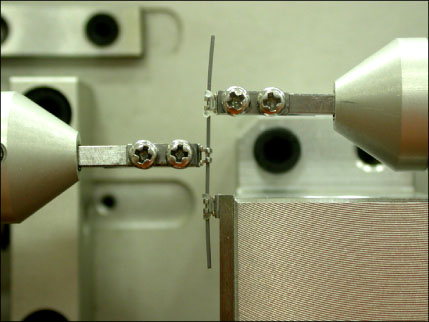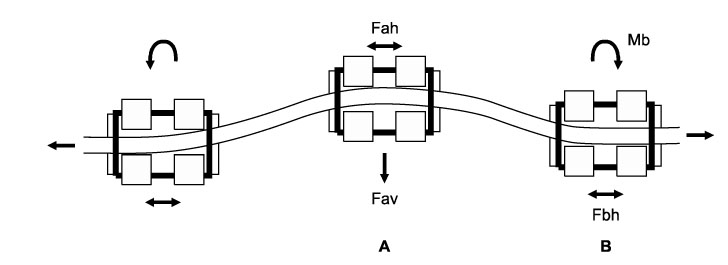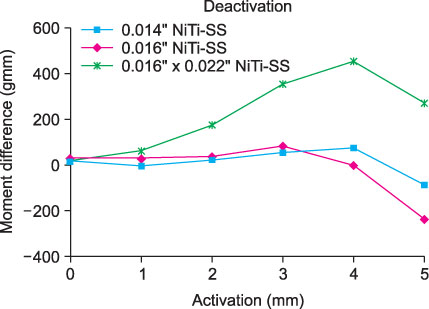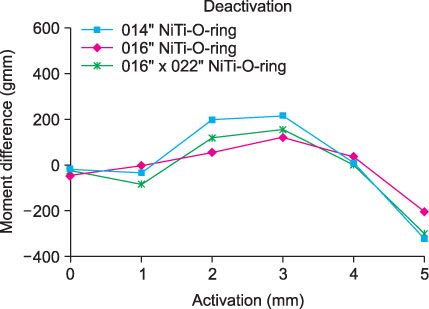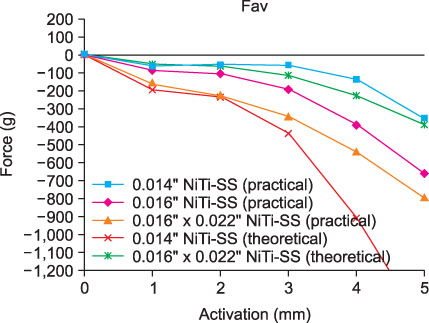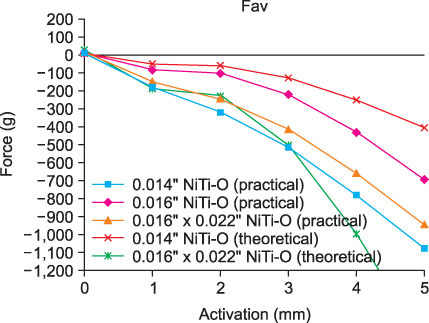Korean J Orthod.
2011 Oct;41(5):337-345. 10.4041/kjod.2011.41.5.337.
Effect of friction from differing vertical bracket placement on the force and moment of NiTi wires
- Affiliations
-
- 1Department of Orthodontics, Graduate School of Clinical Dental Science, The Catholic University of Korea, Korea.
- 2Department of Orthodontics, Seoul St. Mary's Hospital, The Catholic University of Korea, Korea.
- 3Private Practice, Korea.
- 4Department of Orthodontics, St. Vincent Hospital, The Catholic University of Korea, Korea. seonghh@hotmail.com
- KMID: 1975389
- DOI: http://doi.org/10.4041/kjod.2011.41.5.337
Abstract
OBJECTIVE
The purpose of this study was to evaluate the effect of force and moment produced by Nickel-titanium wires of different sizes at activation and deactivation according to differing vertical bracket displacement.
METHODS
Superelastic NiTi wires of 3 different sizes (0.014", 0.016", and 0.016" x 0.022") were tied with elastomeric or 0.009-inch stainless steel ligations in a twin-bracket, 0.018-inch slot. A testing machine recorded the effects of simulated activation of 5 distances from 1 to 5 mm and deactivation of 5 distances from 4 to 0 mm, in increments of 1 mm.
RESULTS
Frictional force increased the wire stiffness during loading. Ligation of 0.014-inch NiTi wire with O-ring resulted in a significant increase in the stiffness. On application of orthodontic force for 5 mm of vertical displacement of teeth, the effective displacement in the case of the 0.014", 0.016", and 0.016" x 0.022" NiTi wires was 2 mm, 3 mm, and 4 mm, respectively.
CONCLUSIONS
Our results showed that movement of teeth with large vertical displacement was ineffective because of excessive friction. This finding might contribute to the understanding of the force system required for effective teeth movement and thereby facilitate the application of the appropriate light wire for leveling and alignment.
MeSH Terms
Figure
Reference
-
1. Reitan K. Some factors determining the evaluation of forces in orthodontics. Am J Orthod Dentofacial Orthop. 1957. 43:32–45.
Article2. Hain M, Dhopatkar A, Rock P. The effect of ligation method on friction in sliding mechanics. Am J Orthod Dentofacial Orthop. 2003. 123:416–422.
Article3. Frank CA, Nikolai RJ. A comparative study of frictional resistances between orthodontic bracket and arch wire. Am J Orthod. 1980. 78:593–609.
Article4. Pratten DH, Popli K, Germane N, Gunsolley JC. Frictional resistance of ceramic and stainless steel orthodontic brackets. Am J Orthod Dentofacial Orthop. 1990. 98:398–403.
Article5. Bednar JR, Gruendeman GW, Sandrik JL. A comparative study of frictional forces between orthodontic brackets and arch wires. Am J Orthod Dentofacial Orthop. 1991. 100:513–522.
Article6. Berger JL. The influence of the SPEED bracket's self-ligating design on force levels in tooth movement: a comparative in vitro study. Am J Orthod Dentofacial Orthop. 1990. 97:219–228.
Article7. Ireland AJ, Sherriff M, McDonald F. Effect of bracket and wire composition on frictional forces. Eur J Orthod. 1991. 13:322–328.
Article8. Sims AP, Waters NE, Birnie DJ, Pethybridge RJ. A comparison of theforces required to produce tooth movement in vitro using two self-ligating brackets and a pre-adjusted bracket employing two types of ligation. Eur J Orthod. 1993. 15:377–385.
Article9. Schumacher HA, Bourauel C, Drescher D. The influence of bracket design on frictional losses in the bracket/arch wire system. J Orofac Orthop. 1999. 60:335–347.
Article10. Choi WC, Kim TW, Park JY, Kwak JH, Na HJ, Park DN. The effect of bracket width on frictional force between bracket and arch wire during sliding tooth movement. Korean J Orthod. 2004. 34:253–260.11. Joo HJ, Park YG. Friction of calcium phosphate brackets to stainless steel wire. Korean J Orthod. 2007. 37:376–385.12. Kahlon S, Rinchuse D, Robison JM, Close JM. In-vitro evaluation of frictional resistance with 5 ligation methods and Gianelly-type working wires. Am J Orthod Dentofacial Orthop. 2010. 138:67–71.
Article13. Reznikov N, Har-Zion G, Barkana I, Abed Y, Redlich M. Measurement of friction forces between stainless steel wires and "reduced-friction" self-ligating brackets. Am J Orthod Dentofacial Orthop. 2010. 138:330–338.
Article14. Suh CW, Jung HS, Cho JH, Kang KH. Comparison of frictional forces between orthodontic brackets and archwires. Korean J Orthod. 2005. 35:116–126.15. Taylor NG, Ison K. Frictional resistance between orthodontic brackets and archwires in the buccal segments. Angle Orthod. 1996. 66:215–222.16. Jeong HJ, Lim SH, Kim KW. Changes in frictional resistance between stainless steel bracket and various orthodontic wires according to a change in moment. Korean J Orthod. 2007. 37:137–149.17. Je YJ, Chang MH, Lim YK, Lee DY. Evaluation of friction of esthetic brackets according to different bracket-wire angulations. Korean J Orthod. 2007. 37:341–350.18. Burstone CJ, Koenig HA. Creative wire bending--the force system from step and V bends. Am J Orthod Dentofacial Orthop. 1988. 93:59–67.
Article19. Koenig HA, Burstone CJ. Force systems from an ideal arch--large deflection considerations. Angle Orthod. 1989. 59:11–16.20. Heo W, Baek SH. Friction properties according to vertical and horizontal tooth displacement and bracket type during initial leveling and alignment. Angle Orthod. 2011. 81:653–661.
Article21. Meling TR, Odegaard J, Holthe K, Segner D. The effect of friction on the bending stiffness of orthodontic beams: a theoretical and in vitro study. Am J Orthod Dentofacial Orthop. 1997. 112:41–49.
Article22. Choy KC, Sohn BH. Analysis of force system developed by continuous straight archwire. Korean J Orthod. 1996. 26:281–290.23. Sved A. The application of engineering methods to orthodontics. Am J Orthod Dentofacial Orthop. 1952. 38:399–421.
Article24. Drenker E. Calculating continuous archwire forces. Angle Orthod. 1988. 58:59–70.25. Rock WP, Wilson HJ. Forces exerted by orthodontic aligning archwires. Br J Orthod. 1988. 15:255–259.
Article26. Burstone CJ, Koenig HA. Force systems from an ideal arch. Am J Orthod. 1974. 65:270–289.
Article
- Full Text Links
- Actions
-
Cited
- CITED
-
- Close
- Share
- Similar articles
-
- Evaluation of frictional forces between orthodontic brackets and archwires
- Frictional forces between orthodontic wire and bracket under artificial saliva
- An experimental study on frictional forces of various orthodontic wires under artificial saliva
- Changes in surface roughness of bracket and wire after experimental sliding - preliminary study using an atomic force microscopy
- Comparison of the frictional resistance between orthodontic bracket & archwire

